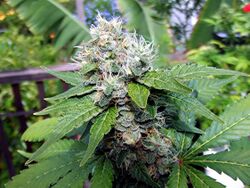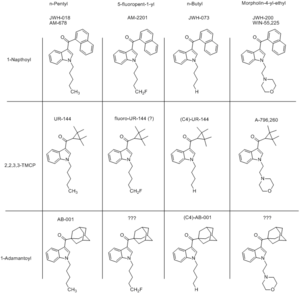Cannabinoid: Difference between revisions
>PJosepherum |
>PJosepherum |
||
| Line 98: | Line 98: | ||
*[[UR-144]] | *[[UR-144]] | ||
====Comprehensive List=== | ====Comprehensive List==== | ||
For a comprehensive list of known synthetic cannabinoid derivatives, [https://www.reddit.com/r/Drugs/wiki/cannabinoids /r/Drugs/wiki] has published a respectable directory of names and links to further information. | For a comprehensive list of known synthetic cannabinoid derivatives, [https://www.reddit.com/r/Drugs/wiki/cannabinoids /r/Drugs/wiki] has published a respectable directory of names and links to further information. | ||
==References== | ==References== | ||
<references/> | <references/> | ||
Revision as of 15:17, 22 August 2015
{{#setlogo:SmallStonedStare.gif}}


Cannabinoids are a class of diverse chemical compounds that act on cannabinoid receptors on cells that repress neurotransmitter release in the brain. These receptor proteins include the endocannabinoids (produced naturally in the body by humans and animals),[1] the phytocannabinoids (found in cannabis and some other plants), and synthetic cannabinoids (manufactured chemically). The most notable cannabinoid is the phytocannabinoid ∆9-tetrahydrocannabinol (THC), the primary psychoactive compound of cannabis.[2][3] Cannabidiol (CBD) is another major constituent of the plant, representing up to 40% in extracts of the plant resin.[4] There are at least 85 different cannabinoids isolated from cannabis which exhibit varied effects.[5]
Synthetic cannabinoids encompass a variety of distinct chemical classes: the classical cannabinoids structurally related to THC; the nonclassical cannabinoids (cannabimimetics) including the aminoalkylindoles, 1,5-diarylpyrazoles, quinolines, and arylsulphonamides; and eicosanoids related to the endocannabinoids.[6][7]
Cannabinoid receptors
Before the 1980s, it was often speculated that cannabinoids produced their physiological and behavioral effects via nonspecific interactions instead of interacting with specific receptors directly. The discovery of the first cannabinoid receptors in the 1980s helped to resolve this debate. These receptors are common in animals and have been found in mammals, birds, fish, and reptiles. At present, there are two known types of cannabinoid receptors, termed CB1 and CB2,[8] with mounting evidence of more.[9][10] However, the role of these interactions and how they result in the cannabinoid high experience continues to remain elusive.
Cannabinoid receptor type 1
CB1 receptors are found primarily in the brain, more specifically in the basal ganglia and in the limbic system (including the hippocampus).[11] They are also found in the cerebellum and in both male and female reproductive systems. CB1 receptors are absent in the medulla oblongata, the part of the brain stem responsible for respiratory and cardiovascular functions. Thus, there is not the risk of respiratory or cardiovascular failure that can be produced by some drugs. CB1 receptors appear to be responsible for the euphoric and anticonvulsive effects of cannabis. However, the role of these interactions and how they result in the cannabinoid high experience continues to remain elusive.
Cannabinoid receptor type 2
CB2 receptors are predominantly found in the immune system, or immune-derived cells[12] with the greatest density in the spleen. While found only in the peripheral nervous system, a report does indicate that CB2 is expressed by a subpopulation of microglia in the human cerebellum.[13] CB2 receptors appear to be responsible for the anti-inflammatory and possibly other therapeutic effects of cannabis.[14] However, the role of these interactions and how they result in the cannabinoid high experience continues to remain elusive.
Subjective effects
The effects listed below are based upon the subjective effects index and personal experiences of PsychonautWiki contributors. The listed effects will rarely (if ever) occur all at once, but heavier dosages will increase the chances and are more likely to induce a full range of effects.
Physical effects
- Sedation - Although certain strains of cannabinoids present mild encouraged stimulation at low to moderate doses, for the most part the effects on the user's energy levels are primarily sedating. This encourages one to relax, but can, however, be suppressed by simply forcing oneself to engage in physical activities.
- Motor control loss - This substance causes a partial to moderate suppression of motor control which intensifies proportional to dosage but rarely results in a complete inability to walk and perform basic movements.
- Appetite enhancement - The feeling of increased appetite following the use of cannabinoids has been documented for hundreds of years[15] and is known colloquially as "the munchies" in popular American and United Kingdom culture. Clinical studies and survey data have found that cannabis increases food enjoyment and interest in food.[16] This is thought to be due to the way in which endocannabinoids in the hypothalamus activate cannabinoid receptors that are responsible for maintaining food intake.[17]
- Nausea suppression - Cannabis is effective for suppressing nausea induced by both general illness and substances. It is considered an effective treatment for chemotherapy-induced nausea and vomiting (CINV)[18] and is a reasonable option in those who do not improve following preferential treatment.[19]
- Dehydration
- Vasodilation - THC decreases blood pressure which dilates the blood vessels and increases blood flow throughout the body. The arteries in the eyeball expand from the decreased blood pressure. Studies in the 1970s showed marijuana, when smoked or eaten, effectively lowers intraocular pressure by about 25%, as much as standard medications.[20] These enlarged arteries often produce a bloodshot red eye effect. It is precisely this effect on the human eye that makes cannabinoids an effective medicine for glaucoma.[21]
- Pain relief - This substance has been reported as being useful for treating certain headaches and chronic pain, including pain caused by neuropathy and possibly fibromyalgia and rheumatoid arthritis.[22][23]
- Increased bodily weight or Decreased bodily weight - Depending on the specific cannabinoid, one can find themselves with a body which can feel either physically heavier or lighter than it usually would in a manner that is entirely dependent upon dosage.
- Changes in gravity - At extremely high doses, many users report a feeling of being pulled backwards across vast distances at powerful speeds. This sensation progressively increases in intensity and eventually becomes unbearable if one leans backwards or lies down but usually disappears altogether once the user sits up or leans forward.
- Spontaneous tactile sensations
Cognitive effects
- Thought connectivity
- Thought deceleration
- Conceptual thinking
- Mindfulness
- Current mind state enhancement - The most prominent cognitive component of the cannabinoid experience is the way in which it enhances the emotions one is already feeling proportional to dosage. This can result in euphoria, extreme laughter, and increased immersion within tasks and activities or it can result in anxiety or paranoia depending on the user's current mind state.
- Information processing suppression
- Anxiety - Certain canabinoids induce anxiety consistently; however, all cannabinoids are capable of inducing anxiety at high doses or with chronic administration.
- Paranoia - Certain cannabinoids induce paranoia consistently and all cannabinoids are capable of inducing paranoia at high doses or with chronic administration.
- Feelings of impending doom
Visual effects
- Colour enhancement
- Visual acuity suppression
- Geometry - Certain cannabinoids are capable of inconsistently inducing mild to intense psychedelic geometry at high doses. Within many users who also regularly use psychedelics, however, it is capable of inducing these consistently in a visual style which seems to be an averaged out depiction of all the psychedelics one has used within the past. These rarely extend beyond level 4 and are considered to be mild, fine, small and zoomed out (but often well-defined).
Auditory effects
Phytocannabinoids

Phytocannabinoids can be defined as any plant-derived natural product capable of either directly interacting with cannabinoid receptors or sharing chemical similarity with cannabinoids or both.
- THC
- CBD
- CBN
- CBG (Cannabigerol)
- CBC (Cannabichromene)
- CBL (Cannabicyclol)
- CBV (Cannabivarin)
- THCV (Tetrahydrocannabivarin)
- CBDV (Cannabidivarin)
- CBCV (Cannabichromevarin)
- CBGV (Cannabigerovarin)
- CBGM (Cannabigerol Monomethyl Ether)
Plant sources
Synthetic cannabinoids
Synthetic cannabinoids are any artificial compound which is functionally similar to Δ9-tetrahydrocannabinol (THC), the active principle of cannabis. Like THC, they bind to the same cannabinoid receptors in the brain and are often sold as legal alternatives.
Toxicity and harm potential
Synthetic cannabinoids are known to be active at microgram doses. Because of this it is extremely important to start very low until a reasonable tolerance is built to the materials.
We have come to understand that negative symptoms associated with synthetic cannabinoid use can be greatly minimised by using reasonably small and accurate doses. Comfortable activity has been reported for many of these substances from simply rubbing plant material on residue from baggies which appear to be empty, however starting at doses ranging from 1mg - 5mg often cause negative symptoms including: anxiety, tachycardia, palpitations, and even systemic toxicity to organs such as the pancreas in one unfortunate member.
Please take extreme care in using these materials, preferably using volumetric dosing of a prepared solution as to always consume a known dosage and understand what your body is comfortable with being administered.
Common substances
Brand-name mystery blends

Please be aware that pre-mixed, branded blends are unreliable as they often fail to list the constituents and dosages. Many people have been hospitalised or suffered negative symptoms believing they are comparable to cannabis in potency and effects. This is not the case, and they should be avoided in favour of pure analytical samples where possible.
Naphthoylindole family
5F family
Pentylindole family
Comprehensive List
For a comprehensive list of known synthetic cannabinoid derivatives, /r/Drugs/wiki has published a respectable directory of names and links to further information.
References
- ↑ The endocannabinoid system as an emerging target of pharmacotherapy | http://www.ncbi.nlm.nih.gov/pubmed/16968947
- ↑ The endocannabinoid system: drug targets, lead compounds, and potential therapeutic applications | http://www.ncbi.nlm.nih.gov/pubmed/16078824
- ↑ Pertwee, Roger, ed. (2005). Cannabinoids. Springer-Verlag. p. 2. ISBN 3-540-22565-X.
- ↑ http://www.unodc.org/unodc/en/data-and-analysis/bulletin/bulletin_1962-01-01_3_page005.html
- ↑ http://www.unodc.org/unodc/en/data-and-analysis/bulletin/bulletin_1962-01-01_3_page005.html
- ↑ The endocannabinoid system: drug targets, lead compounds, and potential therapeutic applications | http://www.ncbi.nlm.nih.gov/pubmed/16078824
- ↑ Pertwee, Roger, ed. (2005). Cannabinoids. Springer-Verlag. p. 2. ISBN 3-540-22565-X.
- ↑ The endocannabinoid system as an emerging target of pharmacotherapy | http://www.ncbi.nlm.nih.gov/pubmed/16968947
- ↑ Evidence for novel cannabinoid receptors | The human brain has more cannabinoid receptors than any other G protein-coupled receptor (GPCR) type.
- ↑ Boron, Walter F.; Boulpaep, Emile L., eds. (2009). Medical Physiology: A Cellular and Molecular Approach. Saunders. p. 331. ISBN 978-1-4160-3115-4.
- ↑ The endocannabinoid system as an emerging target of pharmacotherapy | http://www.ncbi.nlm.nih.gov/pubmed/16968947
- ↑ Is lipid signaling through cannabinoid 2 receptors part of a protective system? | http://www.ncbi.nlm.nih.gov/pubmed/21295074
- ↑ Cannabinoid CB2 receptors are expressed by perivascular microglial cells in the human brain: an immunohistochemical study | http://www.ncbi.nlm.nih.gov/pubmed/15266552
- ↑ Is lipid signaling through cannabinoid 2 receptors part of a protective system? | http://www.ncbi.nlm.nih.gov/pubmed/21295074
- ↑ Mechoulam, R. (1984). Cannabinoids as therapeutic agents. Boca Raton, FL: CRC Press. ISBN 0-8493-5772-1.
- ↑ How Marijuana Works | http://science.howstuffworks.com/marijuana4.htm
- ↑ How Marijuana Works | http://science.howstuffworks.com/marijuana4.htm
- ↑ The Pharmacologic and Clinical Effects of Medical Cannabis | http://onlinelibrary.wiley.com/doi/10.1002/phar.1187/abstract;jsessionid=1E004D7B7E2B5CA792E75A6E83EEC59C.f03t01
- ↑ The Therapeutic Potential of Cannabis and Cannabinoids | http://www.aerzteblatt.de/int/archive/article?id=127603
- ↑ Cardiovascular Effects of Cannabis | http://www.idmu.co.uk/canncardio.htm
- ↑ Is Marijuana an Effective Treatment for Glaucoma? | http://medicalmarijuana.procon.org/view.answers.php?questionID=000140
- ↑ Systematic Review and Meta-analysis of cannabinoids Treatment for Chronic Pain | http://onlinelibrary.wiley.com/doi/10.1111/j.1526-4637.2009.00703.x/abstract
- ↑ Cannabinoids for treatment of chronic non-cancer pain; a systematic review of randomized trials | http://onlinelibrary.wiley.com/doi/10.1111/j.1365-2125.2011.03970.x/abstract